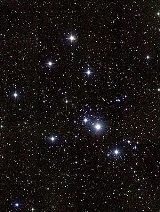
Messier 41
Encyclopedia
Messier 41 is an open cluster
in the Canis Major constellation
. It was discovered by Giovanni Batista Hodierna before 1654 and was perhaps known to Aristotle
about 325 BC
. M41 lies about four degrees almost exactly south of Sirius
. It contains about 100 stars including several red giants, the brightest being a spectral type K3 giant near the cluster's center. The cluster is estimated to be moving away from us at 23.3 km/s. The diameter
of the cluster is between 25 and 26 light years. Its age is estimated at between 190 and 240 million years old. M41 is also referred to as NGC 2287.
Walter Scott Houston
describes the appearance of the cluster in small telescopes:
Open cluster
An open cluster is a group of up to a few thousand stars that were formed from the same giant molecular cloud and have roughly the same age. More than 1,100 open clusters have been discovered within the Milky Way Galaxy, and many more are thought to exist...
in the Canis Major constellation
Canis Major
Canis Major is one of the 88 modern constellations, and was included in the 2nd-century astronomer Ptolemy's 48 constellations. Its name is Latin for 'greater dog', and is commonly represented as one of the dogs following Orion the hunter...
. It was discovered by Giovanni Batista Hodierna before 1654 and was perhaps known to Aristotle
Aristotle
Aristotle was a Greek philosopher and polymath, a student of Plato and teacher of Alexander the Great. His writings cover many subjects, including physics, metaphysics, poetry, theater, music, logic, rhetoric, linguistics, politics, government, ethics, biology, and zoology...
about 325 BC
325 BC
Year 325 BC was a year of the pre-Julian Roman calendar. At the time, it was known as the Year of the Consulship of Camillus and Scaeva...
. M41 lies about four degrees almost exactly south of Sirius
Sirius
Sirius is the brightest star in the night sky. With a visual apparent magnitude of −1.46, it is almost twice as bright as Canopus, the next brightest star. The name "Sirius" is derived from the Ancient Greek: Seirios . The star has the Bayer designation Alpha Canis Majoris...
. It contains about 100 stars including several red giants, the brightest being a spectral type K3 giant near the cluster's center. The cluster is estimated to be moving away from us at 23.3 km/s. The diameter
Diameter
In geometry, a diameter of a circle is any straight line segment that passes through the center of the circle and whose endpoints are on the circle. The diameters are the longest chords of the circle...
of the cluster is between 25 and 26 light years. Its age is estimated at between 190 and 240 million years old. M41 is also referred to as NGC 2287.
Walter Scott Houston
Walter Scott Houston
Walter Scott Houston was an American popularizer of amateur astronomy. He wrote the "Deep-Sky Wonders" column in Sky and Telescope magazine from 1946 to 1993.-Biography:...
describes the appearance of the cluster in small telescopes:
Many visual observers speak of seeing curved lines of stars in M41. Although they seem inconspicuous on photographs, the curves stand out strongly in my 10-inch [reflecting telescope], and the bright red star near the center of the cluster is prominent.

